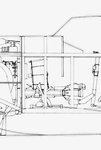davebender
1st Lieutenant
October 1935.
RLM and Daimler-Benz have a nasty dispute over financing for the new Genshagen DB601 engine factory. As a result funding for the engine factory is cut from 50 million RM to 20 million RM. Initial DB601 engine production will be barely adequate for Me-109 and Me-110 aircraft construction. New proposals for DB601 powered aircraft don't stand a chance for lack of engines.
Point of Departure. 1936.
Most European aircraft designers were enthusiastic about the new DB601 engine. The Hungarian Government decides to bankroll DB601 engine production at Manfred Weiss. This will give Hungary a more substantial munitions industry and perhaps earn some hard currency from foreign sales. Unlike some other manufacturers, Manfred Weiss had the expertise to make a copy of the DB605 that was as good as the original.
The Genshagen facility was designed to produce 220 engines per month using two parallel production lines. Manfred Weiss will produce 110 DB601 engines per month using a single production line.
September 1938.
RLM rejects production of the He-100 fighter aircraft.
The He-100 was designed specifically for the DB601 engine and could not be easily modified to use the more plentiful Jumo 211. Thus the program was historically doomed as soon as the Me-109 entered mass production.
Heinkel exports the He-100.
Historically Heinkel sold 6 He-100 prototypes to the Soviet Union and attempted to export the aircraft to Japan. Obtaining permission for license production in Hungary is simple by comparison. Manfred Weiss produced aircraft as well as engines so they are the natural choice. This will be ILO the He-112B which historically almost entered mass production in Hungary.
1940.
A Hungarian variant of the He-100 enters mass production. About 75 aircraft per month powered by Hungarian built DB601 engines. This aircraft has some unique Hungarian features such as the fast firing Gebauer machinegun. It has a conventional cooling system similar to the Me-109.
Battle of Britain.
Germany regrets decisions to curtail DB601 engine production and to not produce the He-100. Beginning July 1940 they will obtain 50 He-100s per month from Hungary, providing an equal value of tanks, artillery etc. desired by the Hungarian armed forces.
RLM and Daimler-Benz have a nasty dispute over financing for the new Genshagen DB601 engine factory. As a result funding for the engine factory is cut from 50 million RM to 20 million RM. Initial DB601 engine production will be barely adequate for Me-109 and Me-110 aircraft construction. New proposals for DB601 powered aircraft don't stand a chance for lack of engines.
Point of Departure. 1936.
Most European aircraft designers were enthusiastic about the new DB601 engine. The Hungarian Government decides to bankroll DB601 engine production at Manfred Weiss. This will give Hungary a more substantial munitions industry and perhaps earn some hard currency from foreign sales. Unlike some other manufacturers, Manfred Weiss had the expertise to make a copy of the DB605 that was as good as the original.
The Genshagen facility was designed to produce 220 engines per month using two parallel production lines. Manfred Weiss will produce 110 DB601 engines per month using a single production line.
September 1938.
RLM rejects production of the He-100 fighter aircraft.
The He-100 was designed specifically for the DB601 engine and could not be easily modified to use the more plentiful Jumo 211. Thus the program was historically doomed as soon as the Me-109 entered mass production.
Heinkel exports the He-100.
Historically Heinkel sold 6 He-100 prototypes to the Soviet Union and attempted to export the aircraft to Japan. Obtaining permission for license production in Hungary is simple by comparison. Manfred Weiss produced aircraft as well as engines so they are the natural choice. This will be ILO the He-112B which historically almost entered mass production in Hungary.
1940.
A Hungarian variant of the He-100 enters mass production. About 75 aircraft per month powered by Hungarian built DB601 engines. This aircraft has some unique Hungarian features such as the fast firing Gebauer machinegun. It has a conventional cooling system similar to the Me-109.
Battle of Britain.
Germany regrets decisions to curtail DB601 engine production and to not produce the He-100. Beginning July 1940 they will obtain 50 He-100s per month from Hungary, providing an equal value of tanks, artillery etc. desired by the Hungarian armed forces.






